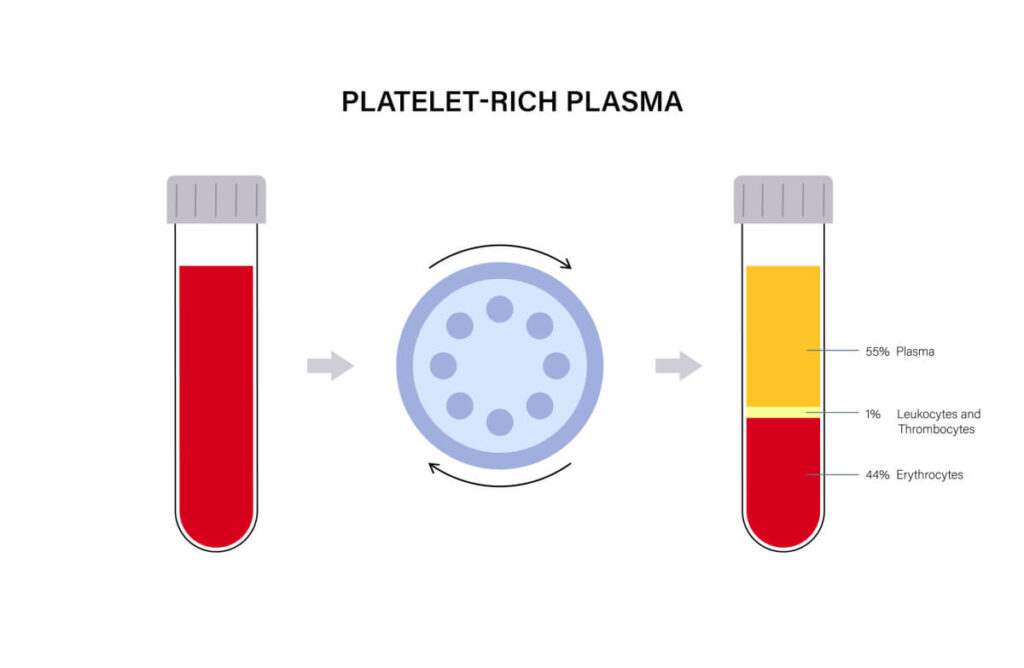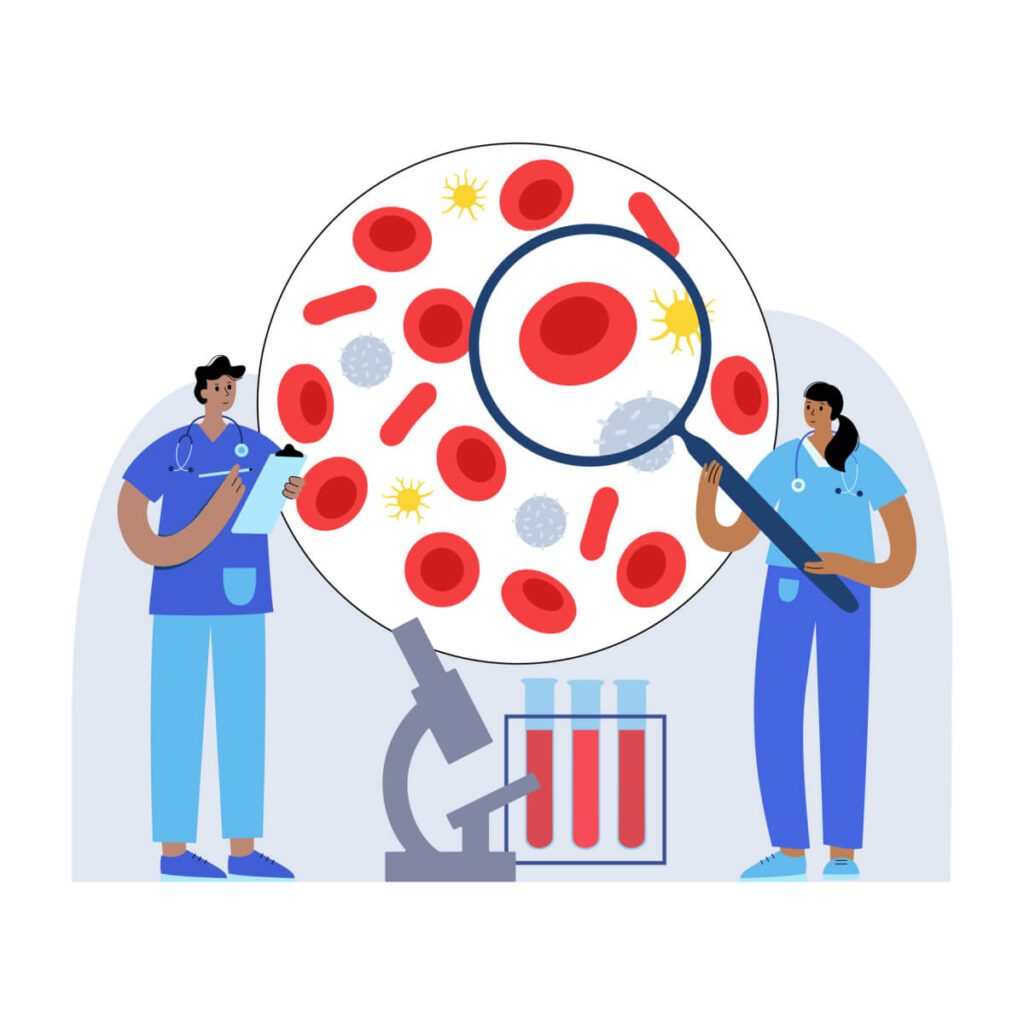Many aesthetic clinicians today are offering platelet-rich plasma therapy as a less invasive procedure for rejuvenating skin and combating hair loss than other procedures. PRP is a cutting-edge treatment option that makes use of the body’s own healing ability to encourage cell repair, collagen regrowth, and tissue regeneration. Now there are a lot of questions surrounding PRP therapy and one of those is where the injections come from.
So how is platelet-rich plasma treatment prepared? PRP uses autologous blood that is drawn from the patient. It’s centrifuged in a high-speed machine to get platelet-rich plasma liquid that contains a high concentration of growth factors. Although it requires a few injections, PRP is a completely safe and low-risk procedure that can treat a variety of cosmetic conditions.
What’s In A PRP Treatment: Understanding How PRP Injections Are Made
Platelet-rich plasma therapy is a type of regenerative medicine that can treat acute sports injuries like torn tendon problems. It also has positive effects for treating musculoskeletal injuries and chronic pain conditions knee arthritis. However, innovations in cosmetic medicine have also shown that PRP offers improvement in symptoms of skin aging and encourages hair growth.
Unlike other cosmetic injections that use neurotoxins or fillers, a PRP serum is produced from a patient’s own blood. Platelets are an essential component of blood which contains numerous proteins or growth factors that have an important role in healing cell and tissue damage. When injected into the desired treatment area, PRP can help your body develop new cells that will accelerate soft tissue healing and repair.
The process for preparing a platelet-rich plasma injection is simple and involves three primary steps:
- Blood draw: The first step in any PRP procedure is the collection of a blood sample. Using a tiny needle, the provider will draw a small amount of blood from the patient. Usually, the proportion of blood that is extracted will depend on what is being treated and where the serum will be injected. For example, PRP for hair loss treatment is said to require at least 20 mL of blood.
- Centrifuge to isolate the platelet-rich plasma: The blood sample is stored in a small vial or tube and then placed in a centrifuge machine to begin the platelet separation process. The machine will spin at high speeds to allow the concentrated platelets to float at the top of the plasma liquid while the other blood cells are isolated at the bottom. The centrifugation process usually takes about 15 minutes to finish.
- Prepare the PRP serum for injection: The centrifugation will typically yield a serum with highly concentrated platelets that are more than what is found in normal blood. The provider will collect this serum in a syringe and immediately inject it into the patient.
Ways To Separate Platelet-Rich Serum From Blood

Clinicians can use different methods to produce a plasma sample with high platelets count. To make the centrifuge process easier, there are various PRP kits available and each of them uses unique segregation techniques to get the platelet-rich plasma serum. Here are the three ways to collect the PRP solution from the blood:
1) Gel separator system
This process is one of the easiest ways to separate the plasma and platelets from the whole blood volume. This technique basically works by spinning the blood in a test tube that is filled with a gel substance. The idea is that it uses osmosis to capture platelets in a gel layer while the other blood cells remain on the other portion. One disadvantage of this gel-based separator system is that it can result in plasma with low platelet concentration.
2) Single spin, buffy coat system
This system generates a thin layer known as the buffy coat which contains a concentration of white blood cells and platelets. To get this buffy coat layer, the blood sample is spun at a very fast speed which will separate the blood cells into three layers. The topmost layer contains the plasma liquid followed by the WBCs and platelets in the middle and the separated red blood cells at the bottom.
Buffy coat-based kits are said to provide a high platelet concentration for PRP injections that is at least 5 to 7 times higher than the normal platelet count.
3) Double spin, buffy coat system
Adding a second soft spin to the initial buffy coat procedure completely isolates the platelets from the red blood cells. With a single spin, there is still a considerable amount of red blood cells that are present in the serum. Taking it for another centrifuge will remove them entirely and leave almost pure platelets in the plasma solution.
Factors That Can Affect Concentration Of PRP Injections

There are several factors that can affect the end product of the centrifugation process for PRP. In addition to having a complete understanding of the whole PRP procedure, clinicians should also take into consideration specific variables such as the patient’s normal blood and platelet levels, method of centrifuge, and use of additives for platelet activation.
1) Patient’s blood composition
The number of platelets that are found in whole blood can vary from patient to patient. If an individual has a certain medical condition that affects their platelet production and function, the PRP treatment may not be as effective for them. This is why it’s important to have a consultation to know if a patient has immune conditions and bleeding disorders that can affect their PRP therapy.
2) Speed and time of spinning
There’s no standard protocol for centrifugation and clinicians can adopt their own methods depending on what works for their practice. However, it’s important to note that the rate at which the blood sample is spun can affect the separation of platelets and blood cells. The greater the force and speed of centrifugation, the more platelets are said to be suspended in the plasma layer.
In addition, the concentration of platelets in the serum can depend on how long it was centrifuged. One clinical evidence has shown that spinning blood for at least 10 minutes can generate higher platelet results.
3) Addition of anti-clotting agents
To help activate the blood proteins and platelets, some clinicians can also opt to add compounds that can enhance the regenerative properties of the growth factors. Some of the additives that they may add are anticoagulant agents which will prevent the blood from clotting during the preparation process. Some compounds like thrombin and calcium chloride can stimulate platelet activation to boost the healing factors of the PRP injection.
Why PRP Injections Are Becoming So Popular

The amazing therapeutic effects of PRP growth factor injections have made it increasingly used for providing pain relief, restoring joint function, and improving the quality of life in individuals with soft tissue injury and musculoskeletal conditions. Here are some of the common injuries that this procedure can help treat:
- Joint conditions like knee osteoarthritis
- Tennis elbow
- Ankle pain
- Discogenic pain and degenerative disc disease
- Acute or chronic muscle injuries
- Torn muscle and knee ligaments
- Injured knee, knee sprains
- Chronic tendon injuries
- Nerve injuries like sciatica
In addition to clinical application, PRP is also being offered in many aesthetic practices for facial rejuvenation and hair loss treatment.
- PRP injections for skin treatment: Also known as PRP facials in many med spas today, this treatment helps revitalize the skin by introducing growth factors and nutrients that can help accelerate cell turnover to remove damaged skin cells and replace them with new ones. PRP can also increase your body’s collagen supply by supporting its production so the skin will restore its youthful glow and suppleness. This form of therapy will help reduce wrinkles and fine lines as well as improve overall skin tone and quality.
- PRP therapy for scalp and hair rejuvenation: PRP is also becoming known as one of the effective treatments for hair restoration. Its injections are said to help improve the signs of male pattern baldness and female pattern hair loss. The growth healing functions of PRP can nourish the scalp and hair follicle, thus improving hair density and thickness and promoting natural hair regrowth.
5 Known Benefits Of PRP Therapy
PRP is a great alternative to surgery for cosmetic and medical procedures. It can also be considered as an all-natural method of treatment since it uses a patient’s own healing factors that are derived from their blood. Here are other benefits of PRP that can convince you to consider getting the treatment:
- Fast and convenient: Although the whole PRP preparation seems complicated, the procedure itself is actually simple and the injections will take no longer than 30 to 60 minutes.
- Minimal side effects: PRP is a safe and minimally invasive treatment and there’s almost no risk for experiencing major side effects from the procedure. The common side effects that patients can get are temporary bruising, swelling, redness, and pain at the injected areas.
- Almost no downtime: Another advantage of PRP is that it offers quick recovery times. Most patients who receive PRP can return to their normal activity after the injection procedure.
- Long-lasting results: Another benefit of PRP injections is that it provides results that can last for at least 12 to 18 months. And because it naturally stimulates your own collagen growth and boosts your healing properties, the injections can provide continuous rejuvenating effects and improvements in the long run.
- Can enhance the effects of other cosmetic procedures: PRP therapy can be combined with other treatments to maximize their effects and aid in the recovery from the procedure. Some of the treatments that can work well with PRP are microneedling, laser skin resurfacing, and dermal fillers.
Is It Risky To Get PRP Injections?

The procedure for PRP therapy is fairly low-risk and since it uses a serum that is extracted from the patient’s blood, the chances of getting an allergic reaction or infection are very rare. However, patients can expect to feel slight dizziness or lightheadedness once the provider starts the blood draw process. For this reason, individuals should make sure that they are well-hydrated and have eaten a heavy meal before their procedure.
There are also other pre-treatment instructions that can help ensure a safe and effective PRP therapy such as:
- Stop taking nonsteroidal anti-inflammatory drugs and corticosteroids at least a week or two before the PRP session. These drugs may inhibit the actions of growth factors and lessen the efficiency of the treatment.
- Avoid blood-thinning drugs and supplements at least five days prior to the injections.
- If you are getting PRP injections for hair loss, make sure to wash your hair before the session.
- Avoid any excessive hair styling or putting on hair dye before getting PRP.
What Does Aftercare Look Like After PRP Injections?
Since it’s not a surgical procedure, the recovery period for the PRP injections is quick. A lot of PRP-treated patients can resume their daily activity with minimal need for aftercare. It’s common to experience mild bruising, pain, and post-injection inflammation but these side effects will normally go away on their own within a few days.
It’s still crucial to avoid any anti-inflammatory drugs for at least 4 weeks after the procedure. They may interrupt the healing function of the platelet-derived growth factors, delay the onset of the treatment effects, and prolong the recovery.
When Can You See Results From PRP Therapy?

The effects of PRP can differ depending on the condition that it is treating. As a hair loss solution, most patients can notice visible improvements in hair thickness and volume within three to six months from their first procedure. The growth of new hairs can typically start within two weeks of administering the PRP injections to the scalp.
Meanwhile, when PRP is used for facial rejuvenation, patients can see noticeable effects on their skin within 2 to 3 weeks after the treatment. For the best outcomes, providers can create individual-based patient treatment plans for multiple PRP sessions depending on the severity of their skin issues.
Is There An Alternative For PRP Treatments?
Some people may still be hesitant about getting PRP due to the fact that it requires blood extraction as the first step of the treatment. Not all people can also be qualified for the treatment especially if they have abnormal platelet function or bleeding disorders. For this reason, it can be a good idea to consider PEP Factor products as an alternative for the injections.
PEP Growth Factor products contain a unique mixture of fibroblasts, copper peptides, and other proteins which can help rejuvenate skin and hair. This treatment comes in a topical formulation so it’s completely free from injections or any blood work.
When applied to the treatment areas, PEP Factor will release growth factors that can stimulate collagen production and cell growth for overall improved skin and scalp health. Similar to PRP, this product can be used to complement other procedures like microneedling or dermabrasion therapy and can enhance the effects of other hair growth treatments.
Shop PEP Factor Products for Skin and Scalp At FACE Med Store
While PRP is already a proven effective treatment for skin and hair rejuvenation, a clinic should always be ready with alternative options to accommodate patients who may want a less complex and non-invasive procedure. PEP Factor can be an excellent natural treatment choice that can help manage skin problems and hair loss.
At FACE Med Store, we offer a wide selection of quality medical tools, supplies, and advanced treatments like PEP Factor products for your hair loss concerns. We’re dedicated to helping aesthetic practices expand their business by making affordable medical products accessible to them. Feel free to browse our stocks online or contact us to find out more about how we can help you.
Learn More: Is PRP Platelet-Rich Plasma A Good Hair Loss Treatment For Radiation Damage?






